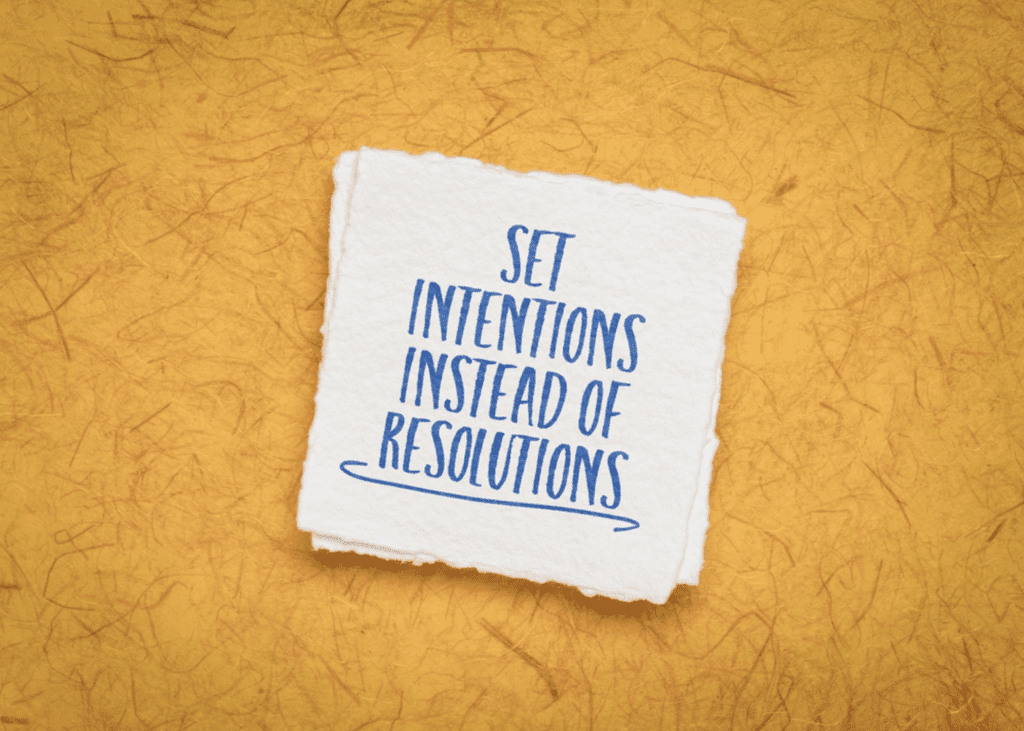If you’ve ever set a New Years’ resolution that you gave up on within a week, you may be familiar with the idea that making resolutions isn’t always a great motivator for achievement. Enter, intention setting.

In a recent episode of the Narativ Story Talks podcast, hosts Jerome and Julienne discussed the reasons why setting intentions may be more important to reaching a goal than the goal itself. Often, we have hurdles in our mindset, attitude, and expectations that can make our resolutions or goals seem too distant to reach. A better approach is to set intentions and allow them to guide our attitudes and decisions from day to day. Doing this will eventually help us to form habits that better serve our goals.
However, many workplaces rely on setting goals to keep their teams focused, productive, and on the same page. However, often their employees end up stressed out and spinning their wheels as they try to reach the set goal. But if goals aren’t actually the best way to keep people engaged, how else is your team supposed to stay motivated enough to reach those goals? Intention setting. And no, it’s not the same thing as goal setting!
Why Intention Setting Works
Goals and resolutions are great, but, as previously mentioned, they often seem too far distant for the work necessary to achieve them to feel satisfying in the meantime. Not only that, but often our underlying intentions can throw us off the path of the goal we’re trying to reach because our attitudes or reasoning isn’t in line with what will actually move us toward the goal in question.
It’s better to start with the intention first so you can gradually correct the course of your goal progress by setting your desired outcomes, choosing the right attitude, and developing better habits. Along the way, you’ll be able to experience and celebrate small successes, and on the whole, you’ll feel a lot more motivated to keep working toward the larger goal.
It’s easy to see how this can translate to the workplace. If your team is finding their set goals more stressful than motivating, it may be time to try a different approach. Here are a few tips for developing a more engaging work environment for your employees with intention setting.
Create Space
One of the fundamental principles we teach here at Narativ is the importance of creating a dedicated time and space for team members to share ideas, give feedback, and discuss mutual goals. This is just as important and effective when using an intention-focused approach.
Creating this space will already make for better team collaboration, but by introducing the idea of focusing on intentions rather than stressing about goals, you can help your team find a lot more ease and flow in the discussion of future endeavors.
One of the added benefits of this approach, is that it can complement the values of the organization and contribute to making those values much more real to everyone. For instance, if you’re having trouble finding an intention, you can use the values of the company as a springboard. Let’s say one of your values is “to have a positive impact on the planet”, then you can ask your team to think about “positive impact” as an intention to follow for a day, a week, or a month, and see how each person in the team works toward that intention.
As intention becomes the guiding focus of these meetings, you’ll find that your team will have an easier time helping one another tackle problems and reach goals without the stress or shame that unmet, lofty goals can cause.
Consistency Over Intensity
As you work with your team to take on a more intention-based mindset, encourage them to think about realistic intentions they can set for themselves. A goal may feel far off, but an intention is simply a way of being. If your team can focus on an intention they can work at a little bit every single day, they’ll be more cognizant of smaller successes along the way and feel far more encouraged to keep going.
An important benefit of this is that your employees will be able to work at the pace that best suits them. This delivers better outcomes, and helps your team to achieve goals over time without the pressure of cutting corners to reach certain metrics. Measured consistency will result in better work and happier people, which will serve your company much better than people who are rushed and stressed. As the saying goes, you want to help your team work smarter, not harder.
Collaborative Mindset
In addition to discussing individual intentions, work with your team to set a group intention that makes collaboration more rewarding. Work toward establishing the group habit of celebrating one another’s individual successes and offering words of encouragement throughout every stage of problem solving. When your team members are rooting for each other it promotes positive reinforcement for individual intention work.
As a manager or team leader, set your own intention to shape an uplifting team atmosphere and follow through in the way you speak during meetings. Your team members will notice and follow suit, and it will lead to a far more collaborative experience for everyone involved.
Individual Attention
As long as you’re setting your own intentions, work on making it a habit to make one-on-one time every week for each of your employees so you can check in on how they’re feeling and help them find solutions for small issues before they evolve into major frustrations. You can also help them think of new ways to stay focused on their intentions based on what they’re trying to accomplish and any roadblocks they’ve been running into.
Making these one-on-ones a frequent occurrence and listening carefully to the needs of your team will serve your own intention of being a more attentive and effective leader—and your team will definitely appreciate it.
Gradual Change is Lasting Change
Because intention-based progress takes a little longer than simply making the resolution itself, you might worry that this is a less efficient way to get things done. It may seem that way at first, but with patience and persistence, you will start seeing improved habits, attitudes, and motivation that will help everybody achieve a lot more without burning out.
Take the focus off the resolution, and you’re much more likely to reach the goal—and then move on to the next goal with a team who is refreshed and excited to take on a new challenge. For more information on how Narativ can help you create a more engaging workplace through positive team building, visit us here. Or, schedule a 15-minute consult with our CEO, Jerome Deroy, to get started today.



